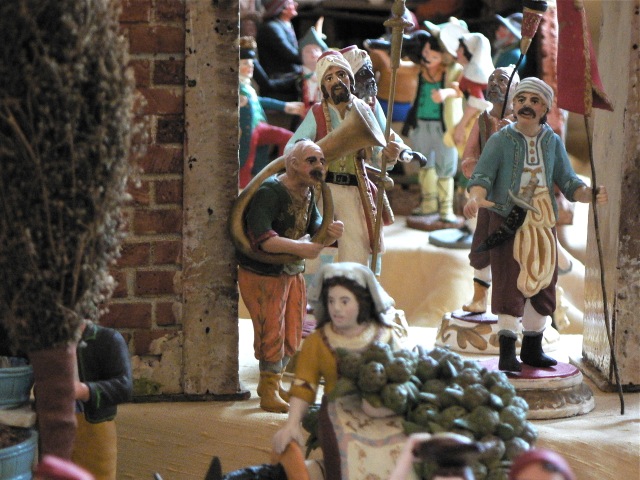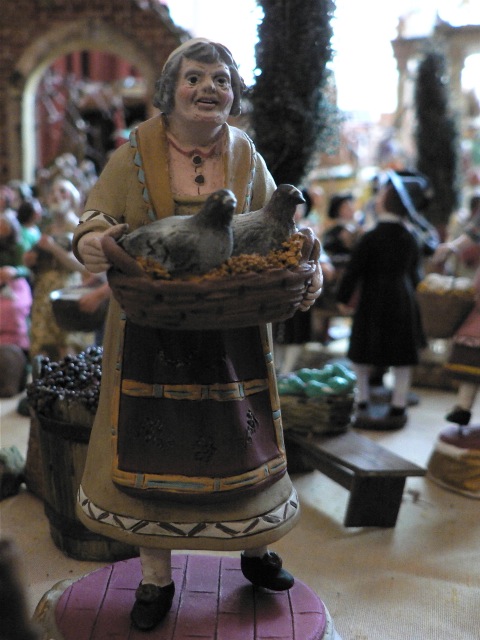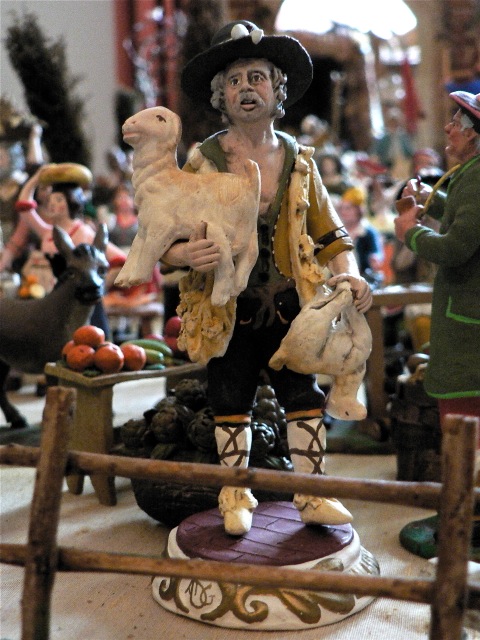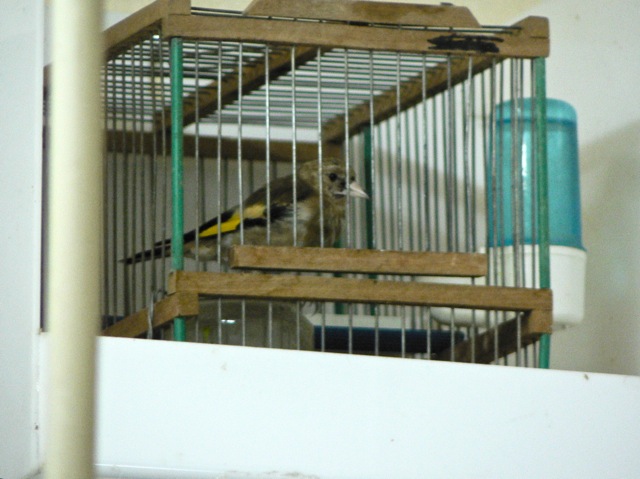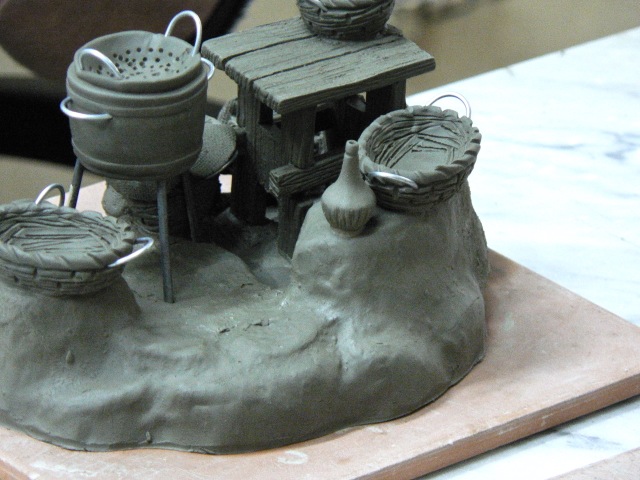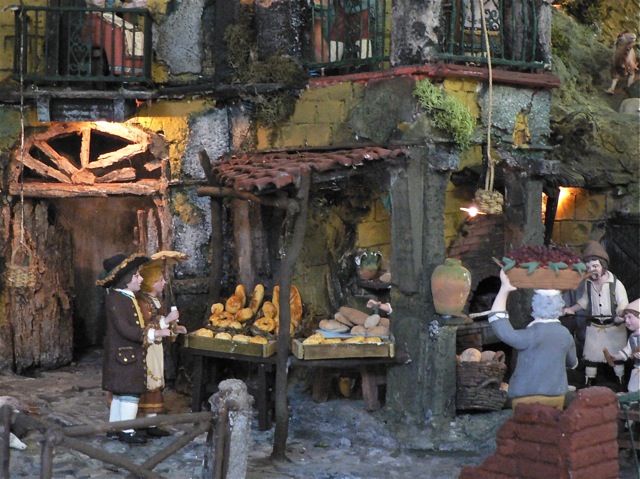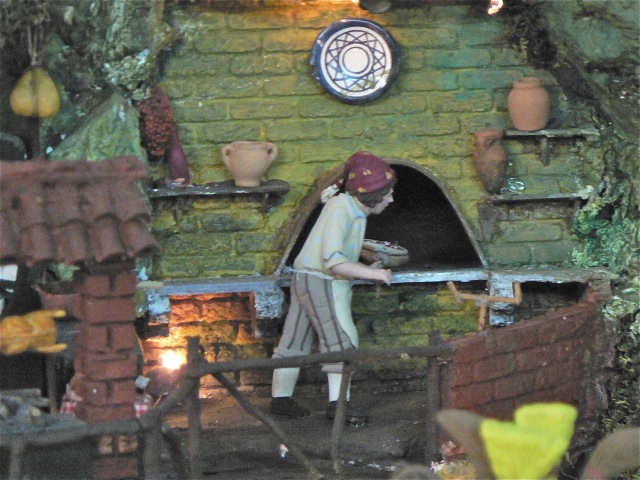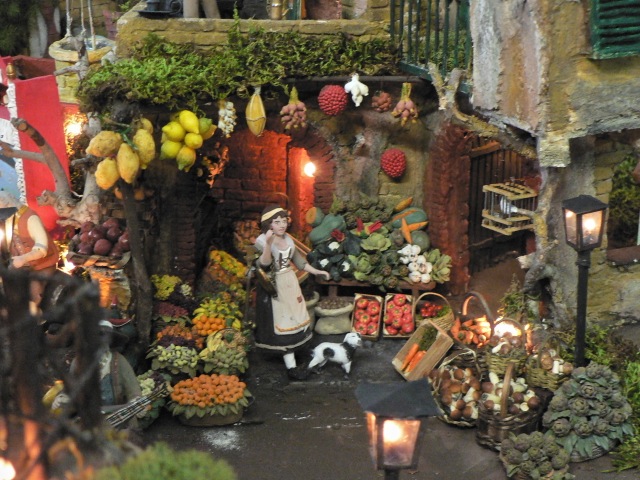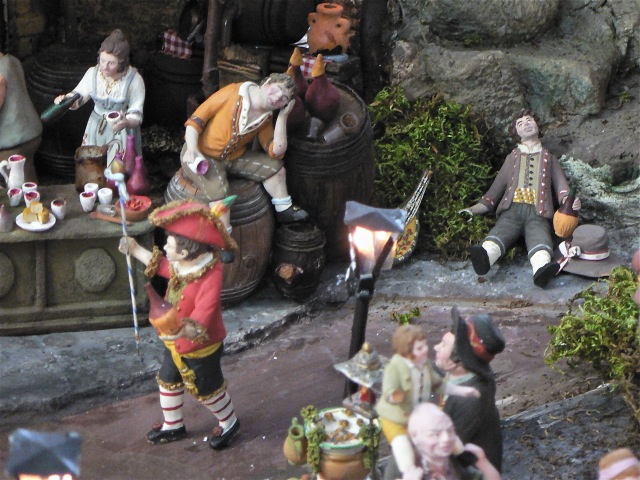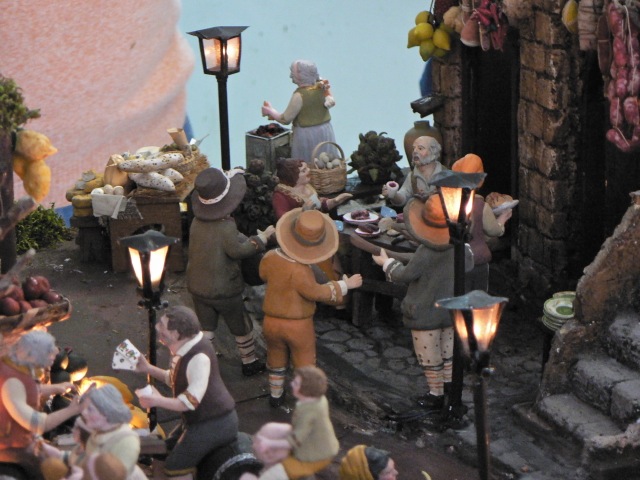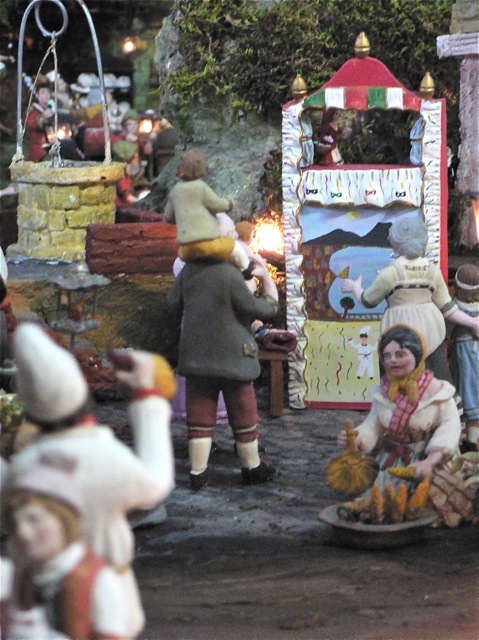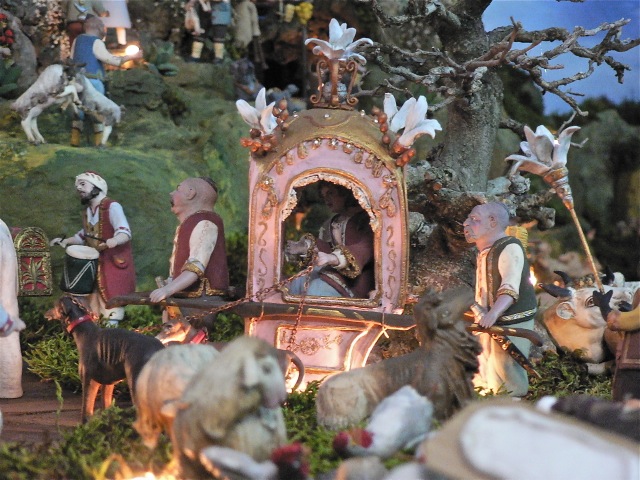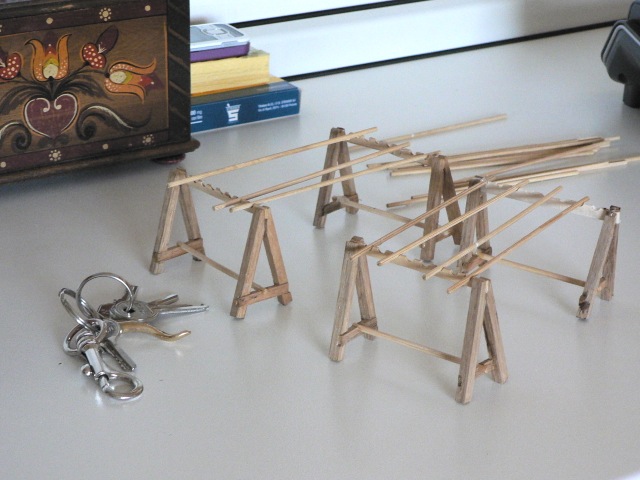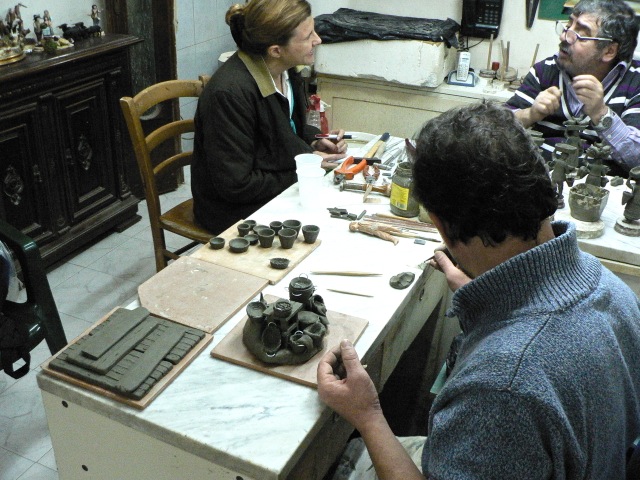A Neapolitan Presepio and its Makers
It was with some trepidation that I stepped off the Eurostar train in Naples last week. I was pleased to be there, a city that must be among the most interesting in Europe, with remarkable food, kind people, splendid museums — and 2800 years of history. I was anxious because, amid the endless reports that Italian artisan production is fast dying, I would find a deterioration in the quality of artisanry in the man I had come to visit. One Armando del Giudice, who had for several years been the only Neapolitan artist who was producing creche figures of a very high artistic level. However, this was 10 years ago.
A chain smoker, would Armando still be well enough to produce these remarkable statuettes, for use in the home presepio, or, following the trend so gloomily reported in Italian newspapers, would a general decline characterize his own production of a traditional Italian artisan craft ?
The photo above and the three below portrays several 3.75 inch (12 centimeter) creche (presepio) figures I acquired either in Rome (at the annual Piazza Navona market), at Naples’ Via Spaccanopoli (heart of the presepio district) or from Armando’s own workshop.
Stepping out into watery Neapolitan sun at the Stazione Centrale, I found a mass of close to 100 taxis before me. Several beckoned frantically. Eventually I found myself seated in the sagging backseat of tassista Gennaro Cozza who told me right away that he would not put on the meter as I was expected to pay his return fare too. “Okay ?” he said, with a contorted grin, swivelling his head all the way around to gaze at me as we plunged head on into Tangenziale traffic. And then stopped, for long periods, in deadlock, with cars approaching to the left, the right, the front and the back. “Col mio lavoro ho il fegato a pezzi“, he remarked, looking around (“in this job my liver is in pieces”.) I inhaled the putrid air. Refineries were to our left, and Chinese-owned silk flower making factories to the right. “Many drivers would have refused to take you to Barra (Armando’s Neapolitan suburb.) Not I. No, my sister lives over there” he said, pointing to a destination beyond a refinery. “Does she like it ?” I inquired. “Yes, she does”. “Did you live well in Naples ?” Gennaro, without skipping a beat : “Yes of course.” Then : “I could live nowhere else.” He took out a package of cigarettes, tapped one out, held it unlit to his lips. “Milan is all money. Florence is art. Rome is government. But Naples ! Naples is culture ! Culture ! Italian culture is all Naples and south !” Twenty minutes later we arrived in Barra but not before Gennaro had locked all four doors and gotten out to ensure that the trunk was locked too. “I am not letting you out until I see who is receiving you” he said. “Presepi eh ?” (I had told him what we were doing). “Let me call a few friends in Naples who make presepi and you can go and see them. One of them lived in New York for a long time. Veri artigiani. ”
Two ladies peered into our taxi. No, in response to the taxi driver, they did not know Armando and they did not know where his apartment was. Presepio figures ? Artisan laboratory ? Puzzled, they shook their heads. Just then Armando’s 22 year old son Aldo ambled down a roughly paved road which was flanked by graceless Fascist-inspired grey apartment buildings, one after the other, arranged in a grid pattern. “Can I hop in ?” he inquired of Gennaro. We drove for one minute. Gennaro unlocked our doors and, thanking us for his double fare, gingerly pulled away, destination again the Tangenziale.
Meanwhile I trotted behind Aldo, through a door, along a narrow ground floor corridor, drawing closer to — was it — the music of many songbirds ? Aldo opened a door. And there, in a small workshop, seated behind a table, with a wooden sculpting tool in his hand, was Armando del Giudice. Two large posters of the famous 17th century Cuciniello presepio at the Naples Capodimonte Museum were over head. Another one of the superstar saint, Padre Pio. Pictures of a sensually handsome Armando as a teenager.
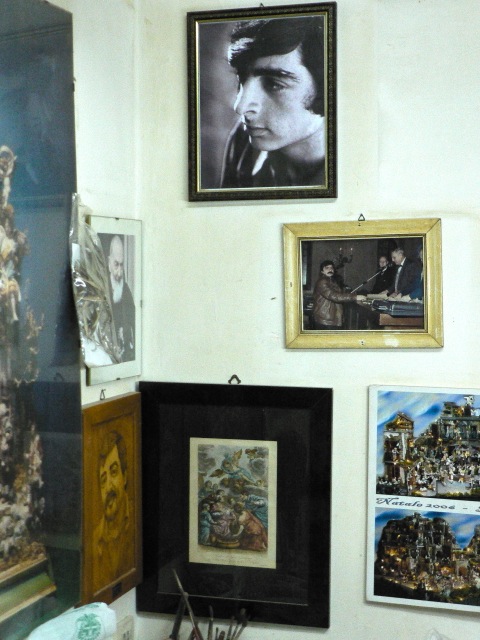
And overhead, in tiny cages, little birds sang and sang, filling the studio with liquid warbles.
“Margherita !” said Armando, as though we had last met each other a few days ago, and not 10 years. “Massimo, make Margherita a coffee”.
There was no wreak of smoke. Armando had kicked the habit. In his early 60s perhaps, with a leather necklace around his neck with a single blue bead. A cell phone, which rang constantly, was at his hand. And a spare, marble work table, with on it one figure of unfired clay, was before him, a shepard with a trussed sheep wrapped around his neck.
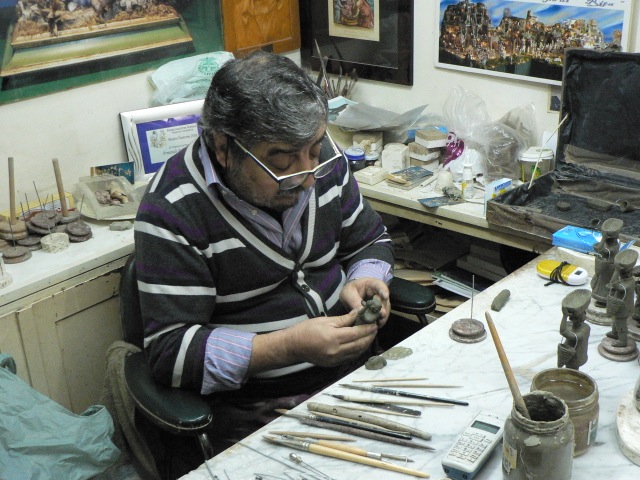
Armando’s son returned to his little table, making up the fifth member of the presepio making staff in the Barra ground floor workshop. Armando’s job was the most important : to make the torso molds and then to create the detail on each figure as it emerged from the mold, adding arms, legs and hands, all of which are modelled entirely by hand. Armando forms and delineates with clarity each tiny finger, musculature of an arm, flex of an elbow, undulation of a rib cage and chest, and most of all, models the face.
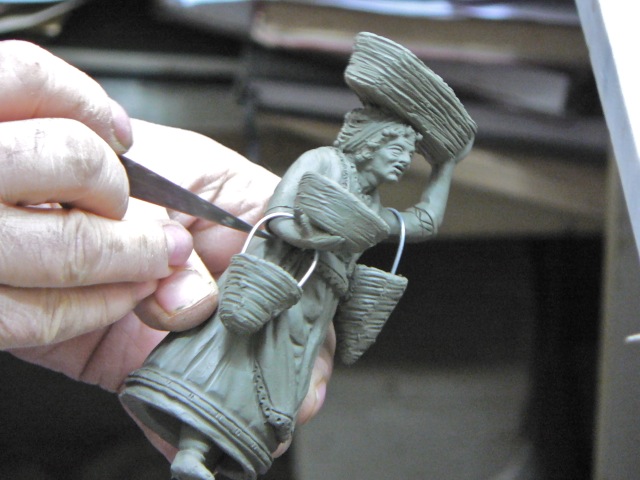
Central to every Armando presepio figure is an expression of wide-eyed wonder, often made more dramatic still by a partially opened mouth (with tiny little white teeth). Again, all on a figure that is four and three quarter inches high.
Across the room, Armando’s older son, Gianluca, hung over a large picture book, and studied carefully a photo of a beautiful courtesan, a two foot high church figure now kept in a private Berlin collection. Using his hands and a small wooden tool, he was molding the bodice of a personage he had never made before, and that might, he said, if she worked out well, become a new prototype.
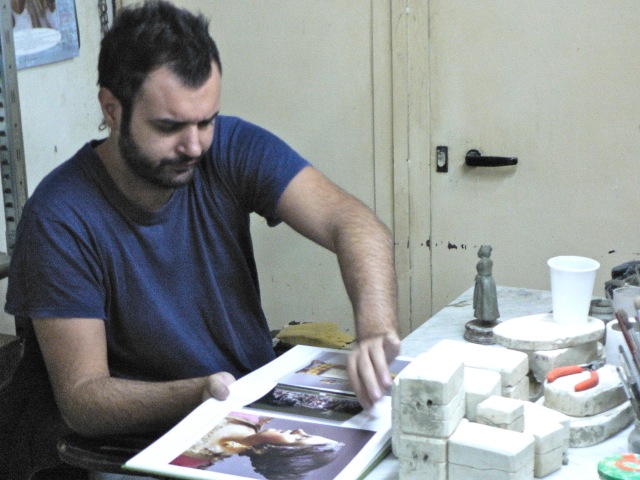
Overhead was a library of other picture books of major presepio collections throughout Europe. To Gianluca’s left was Armando’s brother Carlo, whose job is to paint the figures, using pigments that are unusual in their vibrancy, nuances and saturation, and which he blends himself.
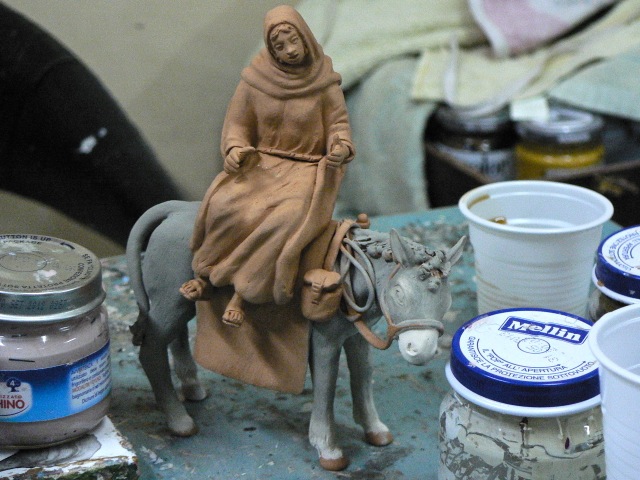
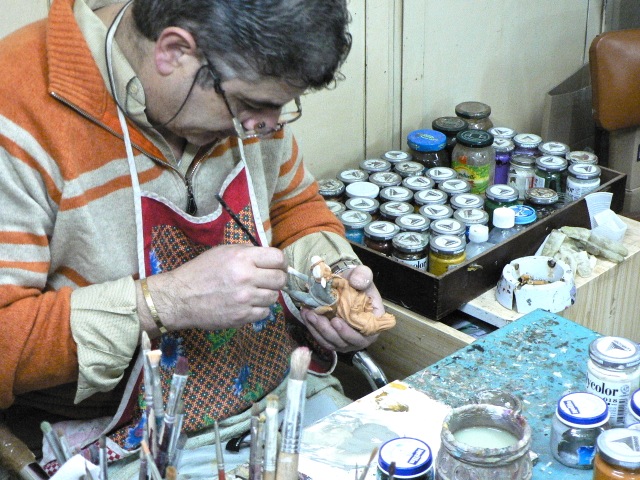
He took regular drags of a steam-filled cigarette, puffing white clouds into the air. I asked him how it was that he and his brother got into the presepio business. Our maternal grandparents were presepio makers, he said. It is in our DNA.
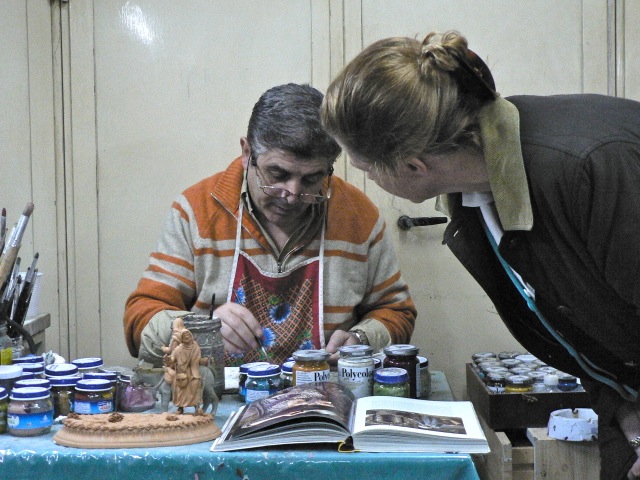
To his left was Armando’s second son, Enzo, whose job was to paint a light “antique” patina on each figure which softens colors. He also specializes in heads, and follows very closely everything that his father is doing.
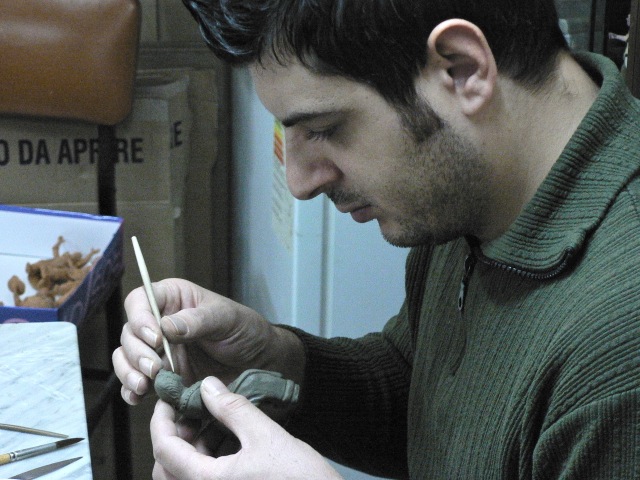
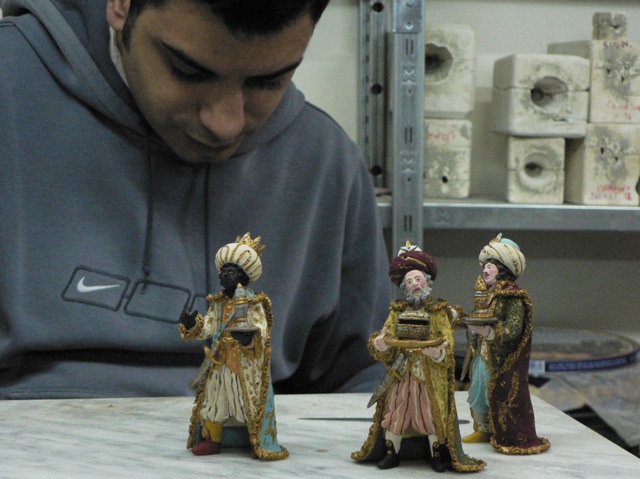
On the other side of the laboratory, beside Armando, was Massimo, the only employee who claimed to have no presepio making skills in his DNA.
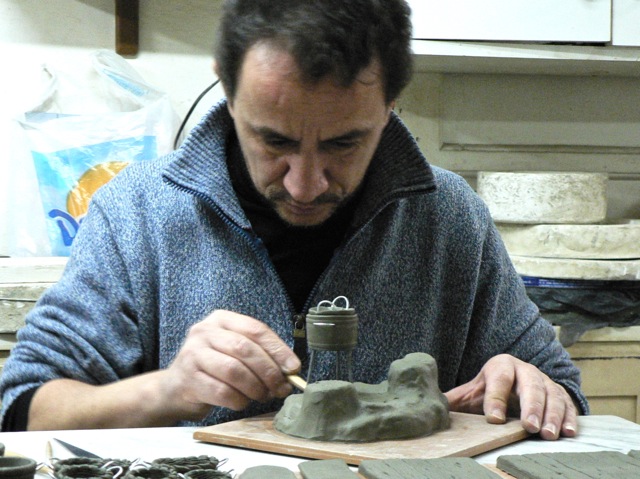
As a child he would come to often to visit his neighbor Armando because he was enchanted by the many cages of songbirds. Soon after he was cleaning cages and filling food dishes, and not long after, when Armando recognized his innate gifts for sculpting, making baskets, bases and other accessories which complete so many of Armando’s figures. 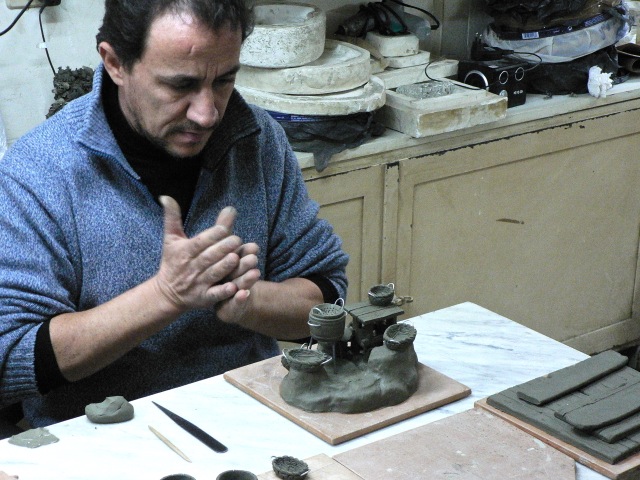
When we arrived Massimo had before him a flat lump of clay. His concentration surely disturbed by our conversation and Armando’s frequent phone calls, he nevertheless managed in the course of two hours to hand mold a perfect chestnut roasting pan, three baskets for chestnuts all ready to be filled and a bottle of wine.
While Armando produces the Holy Family, kings and angels, the majority of his figures (and he has produced more than 1000 different ones) are participants in local life, Neapolitan people who crowd the scene of the Nativity, almost suffocating it with a profusion of life, colors and vignettes, reflecting both poverty and nobility, comic figures and drama, and animals, local and exotic, in a profusion of life that contrasts with the static nativity scene.
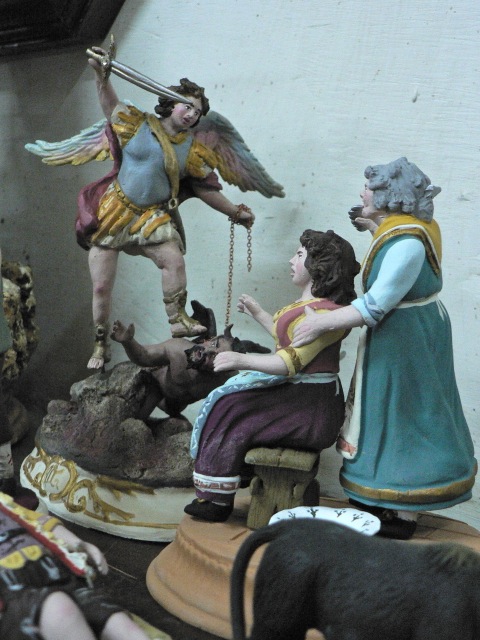
This explosion of Neapolitan humanity subsumes the biblical story and what counts – and where most of the Armando’s energy goes – is in the production of the figures of everyday life. Armando’s figures (and those of all other active Neapolitan presepisti) are all in mid 19th century dress, that is, contemporary with the time of Italy’s unification.
As I moved from table to table, my first, then second, then third thick, sweet espresso cup in hand (near hourly an espresso emerged, unbidden, for us all), I marveled at the quality of artistry of Armando and his colleagues.
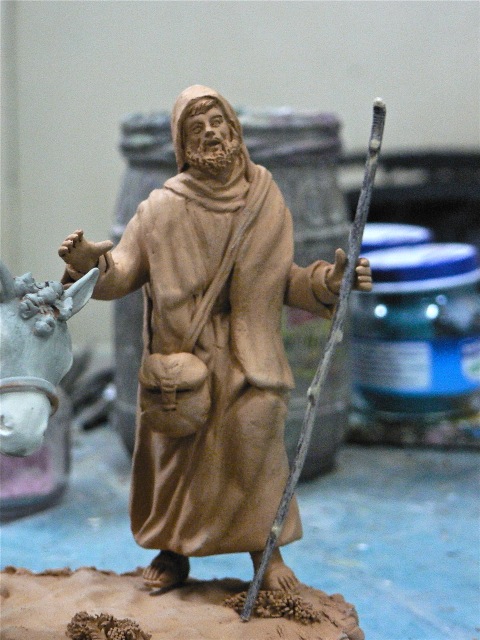
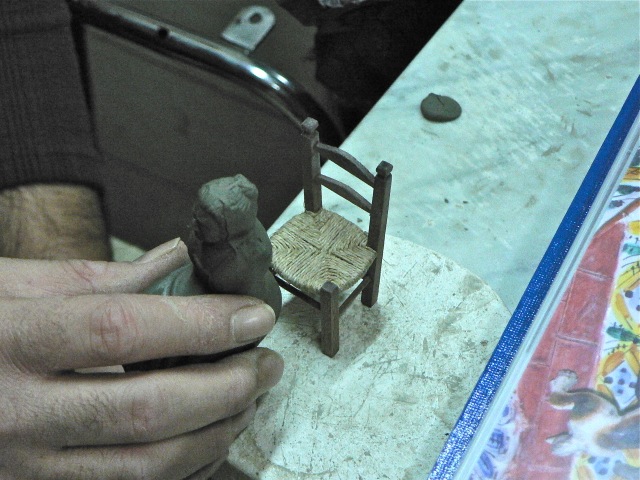
A tall blond woman in glases arrived. This was Armando’s wife Teresa. She kissed me — saying that she remembered me, and had I not bought a lot of her artichokes ten years ago ? Yes, she still made tiny little artichokes, sometimes in baskets, sometimes to be held on a figure’s lap or carried as a gift to the infant Jesus. She and her two sisters also make mushrooms of several types, and a variety of vibrant other vegetables and fruits.
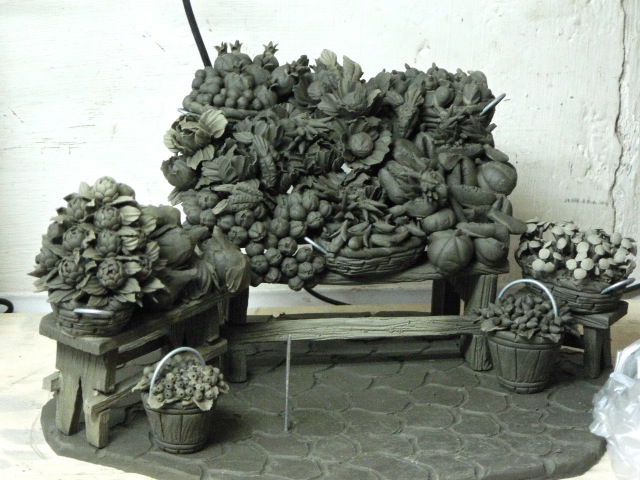
Also her nieces. She had however come to tell the boys that lunch was at 3. Her sons looked up. Working hours were from about 8:30 to 3 and then again around 4 to 8, five or six days a week.
Could I place an order for figures lacking in my own presepio ? Enzo took a notepad. An Arab seller of rugs and silverware, and a salesman of presepio figures. A nobleman with two mastiffs. A salesman of brooms and wicker baskets (with the objects piled atop his head.) Two baby water buffaloes.
Armando made a telephone call. Would I like to go and meet a friend, in Torre del Greco, a friend who had been collecting presepio figures from Armando since 1992, and had a collection of 1263 Armando figures and accessories ? It was fortunate that the night before he had just put the finishing touches on his 2011 presepio.
Torre del Greco is the home of Herculaneum, was once a rich town on the sea, and is now a Neapolitan suburb that has seen better times. Dogs wander the streets, and garbage bins overflow their contents onto the sidewalks and roads. But behind a very high wall lives a functionary for the Neapolitan electric company whose passion — since he has a little boy, and first set one up with his grandfather — is the presepio.
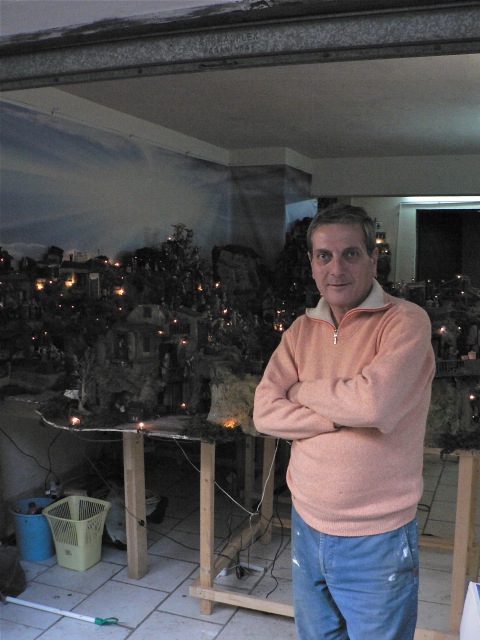
“I go into fibrillation”, said Rosario to me, when we met, outside his garage. He put down a broom as he came to greet me, which he did with a kiss to each cheek. “I go into fibrillation if the presepio is not up by the Immacolata.” The Immacolata, or December 8, is a national holiday and the traditional day that Neapolitans put up their presepi. He then picked up a broom as he lead me into the garage and began immediately to sweep its floor, gathering bits of green moss into a tidy pile.
He flipped a switch. And a dark garage turned into a wonderland, 13 feet by six, of planks supported by wooden horses atop of which Rosario had built a world worthy of every one of Armando’s 1263 miniature masterpieces.
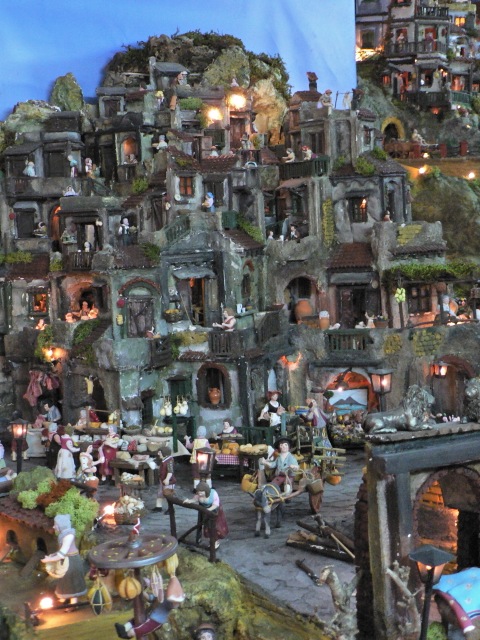
Vast mountains were the backdrop to grottoes, tidy piazzas, a pool for water buffaloes, a crumbling temple to house the Holy Family. There were at least 20 different levels, each ingeniously crafted and entirely by hand by Rosario, using thin stips of corks and occasionally a little paper mache. With excitement he led me around — “peek in this window ! did you see this scene ? can you understand what is happening here ? did you notice these lights ? see the Madonna in the tabernacle ? note the outhouse and now I have finished it ? The tiny street lights — I lost count after 300 — made laboriously from Coca Cola lids ?”
Rosario brought to mind Charles III, the Neapolitan king during Naples’ golden age of the art of the presepio, in the 18th century, who had a passion for mechanics and miniatures, and encouraged and personally directed court architects and scenery producers as well as building himself a presepio in the royal apartments.
His queen and her ladies-in-waiting sewed exquisite little clothes for the figures with material and minute patterns especially produced in the royal fabric factory at San Leucio.
Nobles and rich bourgeois families, anxious to keep up with the monarch, competed with their own presepio. The most beautiful were rewarded with a visit by the king, a much sought after recognition. And the common Neapolitan was allowed into noble homes to admire the sumptuous displays.
Rosario scurried left and right adjusting a few figures.
On Candlemas each year, February 3, his whole presepio comes down, and is stored in many boxes.
For the next eight months he dreams about the presepio of the Christmas to come. The day before he had fallen through one of the boards, while crawling along it, positioning a procession of Moors. He rubbed his leg. Fortunately no figures had been damaged, which was the important thing. The following day he would be setting up the speakers which will broadcast the two recordings he had recently made.
The first recording is local market people, calling out, singing, going about the lively business of selling produce in a Neapolitan market. The other recording is of barn animals : cows mooing, donkeys braying, roosters crowing. “E’ molto suggestivo, trovo” , he commented (“it is very atmospheric I find”).
Upstairs in his apartment, where he keeps what he calls his private presepio, 35 figures only, the Holy Family, moors, musicians, courtiers, kings, musicians and angels.
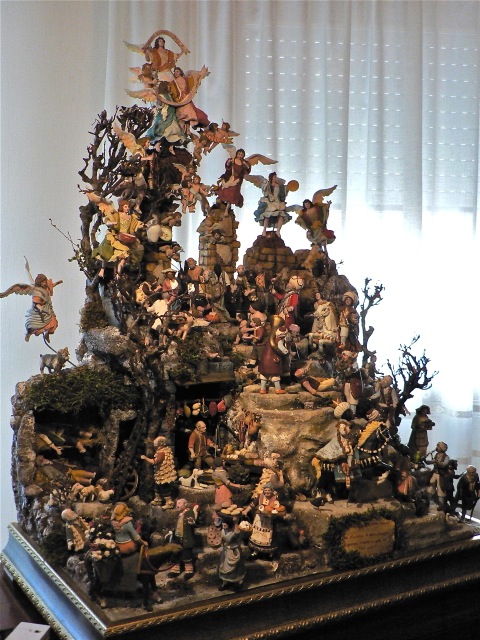
It was lovely, more formal, and quieter. In the kitchen, which looked straight out to the deep green slopes of Vesuvius, another coffee was pressed upon me. As I enjoy the four sweet, intense sips, I admired what seemed like a miniature towel rack made of pine. “A pasta drying rack for the market in my presepio” said Rosario, sipping his own coffee. “My mother in law tonight will cook a few strands of tagliolini — you know, those very fine pastas — for just one minute until they are maleable. And then I will cut them very small and drape them across the rack and the pasta seller figure will have them next to her.”
We parted with kisses and a promise on my part of an imminent return. That afternoon, in Spaccanapoli, a district which must be Europe’s closest remaining vestige of the medieval era, I visited two magnificent formal exhibitions of reproduction 18th century figures, all of which were purpose-made for these two shows. Just a few steps was San Gregorio degli Armeni, the center of the presepio business, where nearly every store sells either the 3.75 inch size figures or copies of the 18th century, formal ones. Some stores specialize in just accessories — tiny paddles for pizza ovens, miniature hammers, fishing poles, house tiles, mozzarelle — all of the little pieces that make more fantastic and realistic the presepio world.
The sound of hammering was all around — artisans driving nails into cork sheets, modelling towns, grottoes and restaurants which would find homes in Neapolitan’s presepio displays. I bought a fountain, with two spouts. And around midnight returned back to Rome, in a state of joy and satisfaction – and quasi disbelief that such a world of high artisanry was still so alive, and so well.

